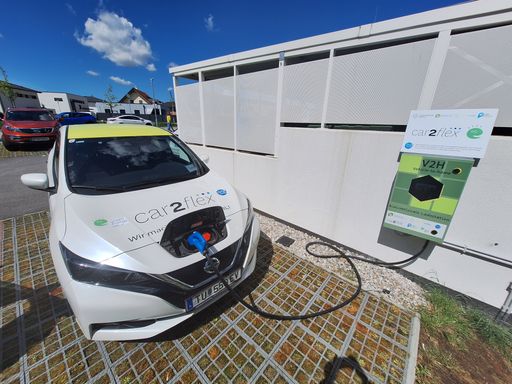First bidirectional charging stations for car sharing use from fahrfreuden.at awarded the “Austrian Solar Prize”: The pilot application at two locations in Lower Austria is part of the “Car2Flex” research project from the Green Energy Lab.
As part of the “Car2Flex” research project, an Austria-wide pilot application for the bidirectional operation of electric vehicles in conjunction with car sharing was implemented. Bidirectional – this means that the vehicle battery is not only charged with electricity, but can also supply it back to the grid if necessary. The application was recognized on October 5, 2024 by awarding the Austrian Solar Prize in the category of transportation systems with renewable energies.
„We congratulate all partners of the ‘Car2Flex’ project on their well-deserved award. Bidirectional charging allows electric cars to be used as buffer storage. This can enable the further expansion of renewable energy production, support the integration of electromobility into the energy system and at the same time stabilize the power grid
“, says Andrea Edelmann, chairwoman of the Green Energy Lab research initiative.
The mobility association fahrfreuden.at combines its car sharing offer with an application as an electricity storage device for multi-party residential buildings. Specifically, members have access to electric cars with a 40 kWh battery. The vehicles are reserved via a booking platform. When the cars are not in use, they park in front of a residential complex belonging to the Lower Austrian Building and Settlement Cooperative in Stockerau or the Lower Austrian Settlement Works in Absdorf. There the vehicles are connected to a specially developed, bidirectional charging station.
During the day, the electric cars are charged using the in-house photovoltaic system on the roof of the residential buildings. Depending on the booking situation, the vehicle battery is also available as a “mobile storage” for powering the residential complex, for example for lighting the staircase or operating the lift system. Intelligent control ensures that at least 40 percent charge level is always available for spontaneous trips. To make planning easier, there are also financial incentives for early booking of the vehicles: up to six hours before the planned start of the journey, use only costs EUR 7.50 per hour (instead of EUR 9.90). This simplifies the energy management of the vehicle battery and shows how incentive systems can positively influence user behavior.
„We are very pleased about this award and the associated recognition of our pioneering work. Especially because we see this as confirmation that the networked thinking of mobility services and power supply will be of central importance in the future
,” says Matthias Zawichowski, chairman of the mobility association fahrfreuden.at.
Bidirectional charging – this is how “Car2Flex” works
The “Car2Flex” project demonstrates how electric vehicles can be optimally integrated into the energy system by intelligently using the capacities of the drive batteries. Thanks to the innovative charging station, electric vehicles can be both charged and unloaded, for example to serve as buffer storage for households with a PV system or even to relieve the load on the power grid. This means that electric cars can be charged with excess electricity from photovoltaics (PV) during the day and then supply electricity back into the grid in the evening. The user can use the Car2Flex app to define to what extent their battery is available as a grid-use power storage device. For fleets and car sharing vehicles, this can be determined by the operator.
Electric cars could store up to 200 GWh of electricity
There are over 5 million cars in Austria. If they were all equipped with a battery of 40 kWh (kilowatt hours), this would result in a total storage capacity of 200 GWh (gigawatt hours) – that is more than the national electricity consumption of a whole day. By charging electricity when there is excess energy and feeding it back into the grid when electricity demand increases, the vehicles can significantly reduce the load on the system as a whole. In doing so, they also support the further expansion of renewable energy production, such as solar and wind power, which are very volatile due to changing conditions. These fluctuations in electricity generation could be compensated for by the widespread use of bidirectional charging and the use of traction batteries as buffer storage. All electricity customers would also benefit from this because it would reduce the costs for stabilizing network interventions. In 2023 alone, these cost electricity customers 141.6 million euros.
„Sometimes we didn’t generate enough electricity throughout the day to cover current consumption peaks. So there are short-term bottlenecks on the consumer side. In the future, we will be able to use the electricity from the vehicle batteries to compensate for the lack of electricity in the grid and will not need to put large fossil power plants into operation to do this.”
says Georg Lettner, project manager of Car2Flex.
Field trials in Lower Austria continue successfully
The bidirectional charging stations are operated exclusively for two electric car sharing cars at the Stockerau (Gustav Mahler-Promenade) and Absdorf (Wiesenstraße 1) locations. The residential complexes each have a PV system on the roof with a maximum output of 8 or 10 kWp. The housing developers involved in the project, the Lower Austrian Building and Settlement Cooperative (NBG) and the Lower Austrian Settlement Association Non-profit Society (NÖSW), want to provide affordable mobility in conjunction with future-oriented technologies. This mobility offer is operated by the mobility association “fahrfreuden.at” in cooperation with the technical office im-plan-tat. In addition to a large number of regional partners, it is also supported by the Energy and Environment Agency of the State of Lower Austria.
The “Car2Flex” project is carried out as part of the Green Energy Lab research initiative and is supported by the Climate and Energy Fund using funds from the “Energy Showcase Region” program. Project partners include the technology companies Schrack and Fronius as well as the energy supply companies EVN, Burgenland Energie and Energie Steiermark.
